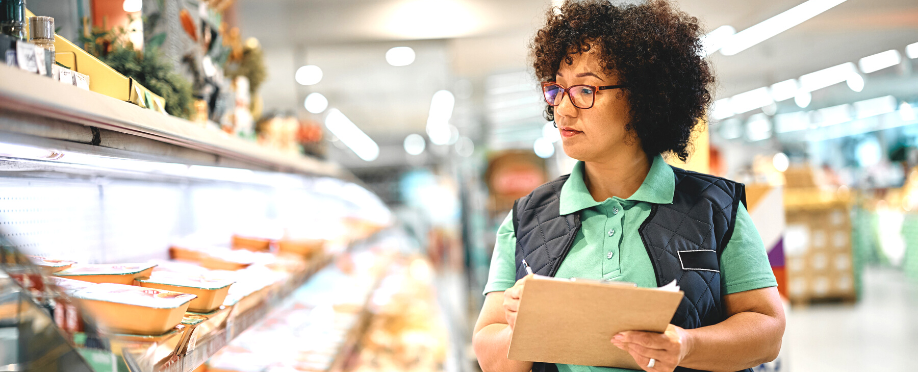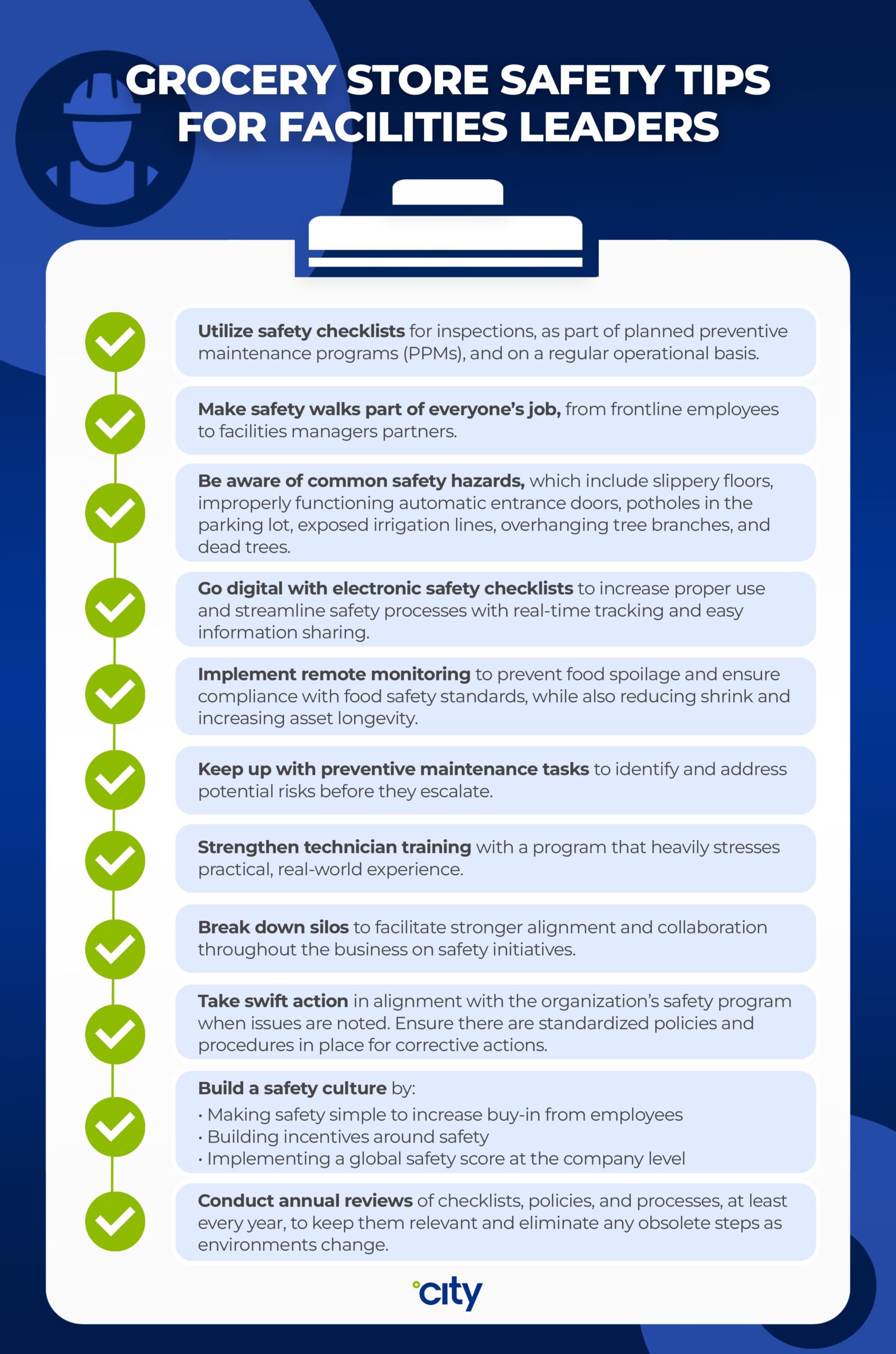
Ensuring the safety and well-being of both employees and customers is paramount to retail facilities managers. This makes implementation of a grocery store safety checklist, retail store safety checklist, and other safety checklists a vital FM function. But the safety checklist, as central as it is, is just the start of an effective safety program.
We spoke with James Halaszynski, Director of Safety for City Facilities Management, to learn more about grocery store safety checklist best practices and strategies for elevating grocery store safety standards. Keep reading for some of the insights he shared with us.
What is the purpose of a grocery store safety checklist?
A grocery store safety checklist is a foundational element of any safety program used in inspections, as part of planned preventive maintenance programs (PPMs), or on a regular operational basis.
“From a local perspective, it ensures all safety measures are in a standardized form, ensuring consistency so that all locations are safe for employees and customers alike,” says James.
From a legal standpoint, maintaining thorough documentation and standardization serves as a protective measure. In the event of an incident, a well-documented safety checklist provides a solid foundation and strengthens the organization’s position in case of legal action.
Grocery store safety checklists can vary from inspection checklists to incident reporting checklists, but they have the following in common: they provide essential operational information, ensure consistency, standardize processes, and save time.
Types of grocery store safety checklists include:
- Daily manager checklist: On a daily basis, store managers should walk the aisles checking temperatures in coolers, looking for water spills on the floor, any type of loose shelving, open electrical panels, and other obvious potential hazards.
- Monthly safety inspection checklist: Regular safety inspections are part of an employer’s responsibility in compliance with the OSHA standards. These are generally conducted monthly and include items such as checking emergency exits, safety latches on food equipment, and PPE, and making sure nothing is stored in front of electrical panels.
- Vehicle inspection checklist: Checklists should be used to ensure all company vehicles are properly cared for and safe to drive.
- New work review checklist: “At City, we implement a checklist for any type of new work,” James says. “This serves as a job safety analysis, ensuring every new task is thoroughly assessed for safety considerations.”
- Incident report checklist: This checklist is used to systematically gather and document essential details surrounding an incident or accident and to ensure all proper safety and legal measures are taken.
Grocery store safety tips
In addition to maintaining a grocery store safety checklist, there are other essential measures for increasing grocery store safety:
Make safety walks part of the job
Safety walks through stores shouldn’t just rest on the shoulders of managers, but they should be integrated into the responsibilities of everyone’s job, from frontline employees to facilities managers partners. Encouraging regular safety walks empowers all team members to actively contribute to safety by identifying potential hazards and taking corrective action.
Safety is essentially a habit, James explains. The habit of taking the time to observe what’s going on inside and outside the store should be trained into all employees and partners.
“In keeping with our tagline, ‘City Sees It First,’ City technicians are trained to do safety walks whenever they respond to jobs in a store,” James says. “They won’t hesitate to barricade off an area and initiate a service call if they notice any potential risks.”
Be aware of common safety hazards
Facilities managers should stay vigilant and educate their teams about common safety hazards in grocery stores. According to James, some of the most common safety hazards in the food retail industry, which can put retailers at serious legal risk, include slippery floors, improperly functioning automatic entrance doors, potholes in the parking lot, exposed irrigation lines, overhanging tree branches, and dead trees.
Go digital with electronic checklists
Transitioning from paper-based to digital safety checklists increases the proper use of such forms. Digitalization of checklists also streamlines safety processes by allowing for real-time tracking and easy sharing of information.
Implement remote monitoring
Utilizing technology for remote temperature monitoring can prevent food spoilage and ensure compliance with food safety standards, in addition to reducing shrink and increasing asset longevity.
City’s SPARK+ solution, for example, allows facilities teams to continuously monitor temperatures of refrigeration units, hot bars, and other food and beverage equipment. In the case of any unexpected temperature fluctuations, SPARK+ automatically sends alerts so that the source of any problems can be investigated. “Sometimes it turns out a door was just left open on a refrigeration unit,” James says. “Other times, a technician needs to be assigned a work order.”
Outside of the store environment, remote monitoring on vehicles as well as MVR monitoring, whereby companies are notified of any changes to driving records, can help increase safety on the road.
Keep up with preventive maintenance
Establishing a quarterly preventive maintenance program can help facilities management teams avoid safety issues by identifying and addressing potential risks before they escalate. As a bonus, regular PPMs reduce the costs of reactive calls and extend the life of building assets.
Strengthen technician training
One of the most important investments a facilities management team can make is a technician training program that heavily stresses practical, real-world experience. Properly trained technicians play a critical role in a proactive safety culture by reducing the likelihood of equipment malfunctions and failures that could pose risks.
Break down silos
“In many organizations, it’s not uncommon to silo safety functions in separate departments,” says James, “but at City we put all our safety-related groups under one team for field safety.” As City’s Director of Health and Safety, James oversees field safety support, the fleet team, the risk team, and the legal team.
Consider restructuring your organization in order to facilitate stronger alignment and collaboration throughout the business. Additionally, leaders should actively promote safety as a shared responsibility and encourage cross-departmental teamwork toward common safety goals.
If you work with a facilities management provider, encourage them to share any helpful information that will improve safety for the organization. “We’re very big on having open books and transparency at City — we share all our insurance costs, claims data, and other information in order to help protect our partners and save on costs,” says James.
Take action
Remember, the purpose of a grocery store safety checklist is not just to identify risks but to take swift action when issues are noted in alignment with the organization’s safety program. Ensure there are standardized policies and procedures in place for corrective actions.
“Completing a checklist isn’t just a paper-pushing process,” says James. “Checklists should be actionable. They shouldn’t just identify safety risks but also resolve them. Otherwise, they’ll fall off your radar.”
Checklists should be actionable. They shouldn’t just identify safety risks but also resolve them. James Halaszynski, Director of Safety at City
By taking swift, proactive action on corrective measures, facilities managers demonstrate their commitment to safety and prevent potential hazards from escalating into incidents.
Build a safety culture
The best way to improve the safety of a grocery store or other retail business is to make it a core value that’s deeply ingrained in the workplace culture. Here are some ideas to accomplish this:
- Make safety simple: The more you complicate safety, the harder it will be to get buy-in from employees. To keep people engaged, stay focused on what’s most important to safety. Also, make documentation and the resolution process easy.
- Build incentives around safety: Create incentives, such as recognition or rewards (like bonuses or time off), tied to safety performance in order to encourage staff to prioritize and contribute to overall safety goals.
- Implement a global safety score: Bring visibility to safety at a company level with an overall safety scorecard. This way, everyone from the CEO down can see, promote, and celebrate improvements on an organization-wide scale.
Conduct annual reviews
Finally, conducting regular reviews of checklists, policies, and processes, at least every year, is a vital part of a thriving safety program. After all, environments can change quickly. By eliminating any obsolete steps and adding relevant new ones, facilities managers can ensure stronger compliance among employees and partners.
Safety-First Integrated Facilities Management Solutions
Fostering a culture of safety within grocery store facilities requires a proactive and multifaceted approach that goes well beyond implementing a grocery store safety checklist. By following the strategies above, facilities managers can play a critical role in shaping their environments into safer spaces.
At City, one of our mottos is “City Sees It First.” We offer an industry-disruptive delivery system for facilities management that’s founded on a self-perform model and takes a 360-degree facilities management approach. The result is a dedicated team customized to your needs with exceptional service, safer and more efficient facilities, and sustained cost savings. Learn more about our integrated facilities management services.



 2016: City US is established in North America, in partnership with Southeastern Grocers (SEG), servicing over 750 supermarkets across 7 southern states.
2016: City US is established in North America, in partnership with Southeastern Grocers (SEG), servicing over 750 supermarkets across 7 southern states. 1985: Willie and Susan Haughey establish City Refrigeration Holdings (UK) Ltd in Glasgow, UK.
1985: Willie and Susan Haughey establish City Refrigeration Holdings (UK) Ltd in Glasgow, UK. 2009: City Australia launches in Melbourne, in partnership with Coles, servicing over 700 supermarkets across the country.
2009: City Australia launches in Melbourne, in partnership with Coles, servicing over 700 supermarkets across the country. 2015: City Asia launches in Kuala Lumpur, Malaysia, in partnership with Dairy Farm, servicing over 205 supermarkets across the region.
2015: City Asia launches in Kuala Lumpur, Malaysia, in partnership with Dairy Farm, servicing over 205 supermarkets across the region.